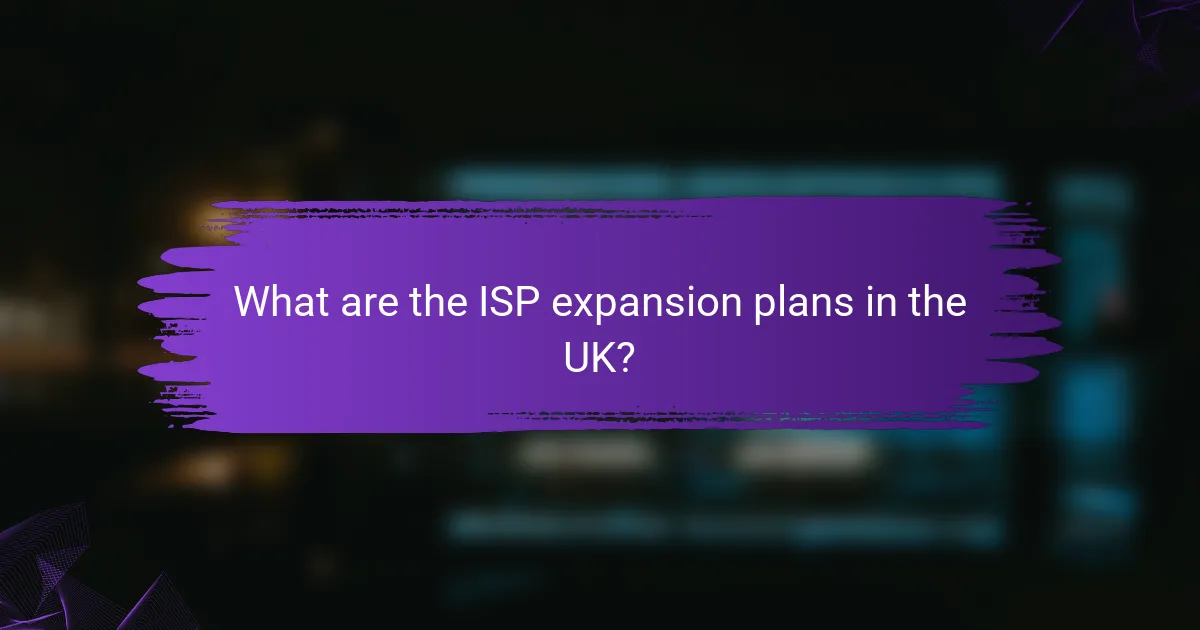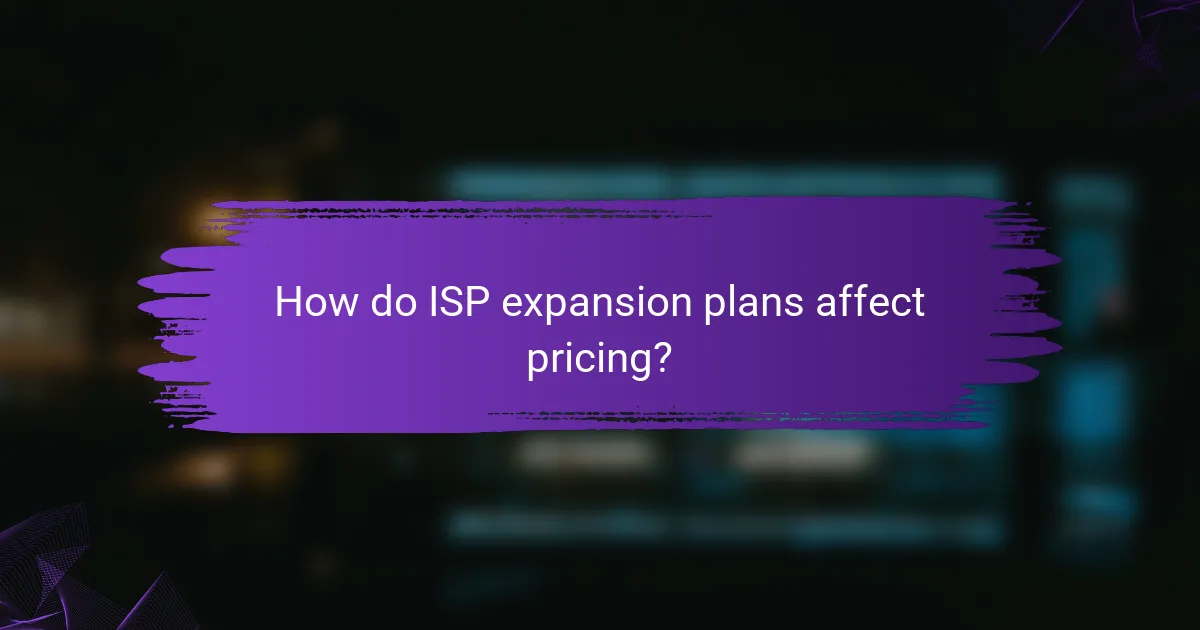UK internet service providers (ISPs) are embarking on ambitious expansion plans to improve coverage and service quality nationwide. Major companies like BT Group, Virgin Media O2, and Sky Broadband are enhancing infrastructure to deliver faster and more reliable internet connections, particularly in underserved rural areas. These initiatives, supported by government efforts and community projects, aim to meet the increasing demand for high-quality online experiences.

What are the ISP expansion plans in the UK?
UK internet service providers (ISPs) are actively working on expansion plans to enhance coverage and improve service quality across the country. Key players like BT Group, Virgin Media O2, and Sky Broadband are implementing strategies to reach more customers and deliver faster, more reliable internet connections.
BT Group expansion strategy
BT Group aims to expand its fiber broadband network, targeting millions of additional homes and businesses by the mid-2020s. The focus is on rolling out full-fiber connections, which offer significantly higher speeds compared to traditional copper lines.
As part of this strategy, BT is investing heavily in infrastructure upgrades and partnerships with local authorities to facilitate quicker deployment. Customers can expect enhanced internet speeds, potentially reaching up to 1 Gbps in some areas.
Virgin Media O2 coverage enhancements
Virgin Media O2 is enhancing its network by expanding its fiber-optic coverage to more urban and rural areas. The goal is to reach around 7 million additional homes by 2025, providing access to high-speed broadband services.
The company is also working on improving its existing network to offer faster upload and download speeds, with some packages promising speeds of up to 1 Gbps. This expansion is crucial for supporting the increasing demand for reliable internet access in the UK.
Sky Broadband service improvements
Sky Broadband is focused on improving its service quality through infrastructure upgrades and the introduction of new technologies. The company plans to enhance its fiber offerings, aiming to provide faster speeds and more reliable connections for its customers.
Sky is also investing in customer service improvements, including better support options and streamlined installation processes. Customers can look forward to increased speeds, with some plans offering up to 900 Mbps, making it a competitive option in the UK market.

How will ISP coverage improve in rural areas?
ISP coverage in rural areas is set to improve through a combination of government initiatives and community-driven projects aimed at expanding broadband access. These efforts focus on enhancing infrastructure and providing affordable service options to underserved populations.
Government initiatives for rural broadband
Governments are increasingly recognizing the importance of broadband access in rural areas and are implementing various initiatives to enhance coverage. Programs such as the Federal Communications Commission’s (FCC) Rural Digital Opportunity Fund in the United States allocate significant funding to support the deployment of high-speed internet in remote locations.
These initiatives often involve partnerships with private ISPs, which can leverage government grants to expand their networks. For example, in the European Union, the Connecting Europe Facility provides financial support for broadband projects that aim to connect rural communities.
Community fiber projects
Community fiber projects are grassroots efforts that aim to establish high-speed internet access in rural areas through local collaboration. These projects often involve residents pooling resources to build and maintain their own fiber optic networks, which can lead to faster and more reliable service than traditional ISPs offer.
Successful examples include municipal broadband initiatives in towns across the United States, where local governments have taken the lead in providing internet services. These projects can significantly reduce costs for residents and ensure that the community has a say in the quality and pricing of their internet service.

What are the expected service improvements from ISPs?
ISPs are focusing on several key service improvements, including faster internet speeds and increased reliability. These enhancements aim to meet the growing demand for high-quality online experiences across various applications.
Faster internet speeds
Faster internet speeds are a primary goal for ISPs as they expand their networks. Many providers are upgrading infrastructure to support gigabit speeds, which can significantly enhance activities like streaming, gaming, and video conferencing.
For consumers, this means that typical download speeds may increase from several hundred megabits per second (Mbps) to over 1,000 Mbps in some areas. This improvement can reduce buffering times and allow multiple devices to connect seamlessly without performance issues.
When considering a plan, check if the ISP offers fiber-optic connections, as these typically provide the highest speeds. Look for promotional offers that may include speed upgrades for a limited time to maximize value.
Increased reliability and uptime
Increased reliability and uptime are crucial for users who depend on consistent internet access. ISPs are investing in more robust infrastructure and backup systems to minimize outages and ensure stable connections.
Reliability can be measured by uptime percentages, with top ISPs aiming for 99.9% uptime. This translates to only a few hours of downtime annually, which is essential for businesses and remote workers who require uninterrupted service.
To gauge reliability, consider customer reviews and service level agreements (SLAs) that outline the expected performance. Avoid providers with a history of frequent outages, and inquire about their response times for service disruptions to ensure you’re choosing a dependable option.

What factors influence ISP expansion decisions?
ISP expansion decisions are primarily influenced by market demand, regulatory frameworks, and infrastructure costs. These factors determine where and how internet service providers can effectively grow their coverage and improve services.
Market demand analysis
Market demand analysis involves assessing the need for internet services in specific areas. ISPs often look at population density, existing competition, and customer feedback to identify regions with high demand for better connectivity.
For example, urban areas with a high concentration of businesses may prompt ISPs to expand quickly due to the potential for higher revenue. Conversely, rural areas may see slower expansion due to lower demand and higher costs associated with infrastructure development.
Regulatory considerations
Regulatory considerations play a crucial role in ISP expansion, as providers must comply with local laws and regulations. These can include licensing requirements, environmental assessments, and adherence to net neutrality principles.
ISPs should also be aware of government incentives or subsidies that may encourage expansion in underserved areas. Understanding these regulations can help ISPs navigate the complexities of entering new markets and ensure compliance while optimizing their expansion strategies.

How do ISP expansion plans affect pricing?
ISP expansion plans can lead to changes in pricing structures for consumers. As providers increase their coverage and improve infrastructure, they may adjust subscription costs to reflect these enhancements or to remain competitive in the market.
Impact on subscription costs
When ISPs expand their services, subscription costs can fluctuate based on several factors. In many cases, increased competition from new or improved services can drive prices down, benefiting consumers. However, if the expansion involves significant investment, some providers may raise prices to recoup costs, which could lead to higher monthly fees.
For example, in regions where multiple ISPs are vying for customers, prices may remain stable or even decrease, while in less competitive areas, prices might increase by a small percentage, typically in the range of 5-15% depending on the extent of the upgrades.
Value-added services
ISPs often introduce value-added services alongside their expansion plans, which can enhance the overall customer experience. These services may include faster internet speeds, enhanced security features, or bundled offerings that combine internet with television and phone services. Such additions can justify higher subscription costs if they provide significant benefits.
Consumers should evaluate whether these value-added services align with their needs. For instance, a family might find a bundled package that includes streaming services worthwhile, while a single user may prefer a more basic plan. Understanding the full scope of what is offered can help in making informed decisions about which plan to choose.

What are the future trends in ISP services?
Future trends in ISP services are increasingly focused on enhancing speed, connectivity, and smart technology integration. As consumer demands evolve, ISPs are adopting advanced technologies to provide faster, more reliable internet access and improved service offerings.
5G technology integration
5G technology is set to revolutionize ISP services by offering significantly higher speeds and lower latency compared to previous generations. This integration allows for seamless streaming, gaming, and real-time applications, making it essential for ISPs to adopt this technology to remain competitive.
ISPs are investing in infrastructure upgrades to support 5G networks, which may involve partnerships with telecommunications companies. Consumers can expect to see enhanced mobile broadband services and the potential for fixed wireless access in underserved areas, providing a viable alternative to traditional wired connections.
Smart home connectivity solutions
Smart home connectivity solutions are becoming a key focus for ISPs as more households adopt IoT devices. ISPs are developing bundled services that include high-speed internet, smart home device management, and security features, catering to the growing demand for integrated home automation.
When considering smart home solutions, consumers should evaluate the compatibility of their devices with the ISP’s offerings. Additionally, ISPs may provide installation support and ongoing maintenance, ensuring that customers can maximize the benefits of their smart home technologies.
